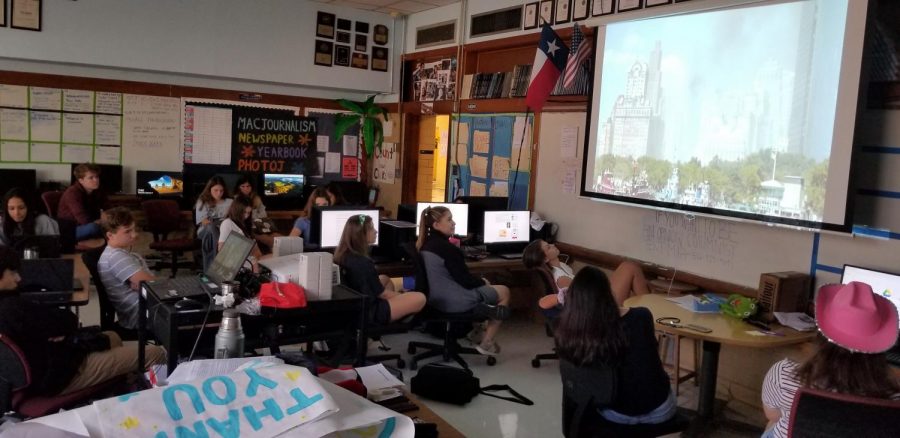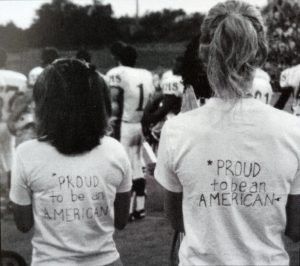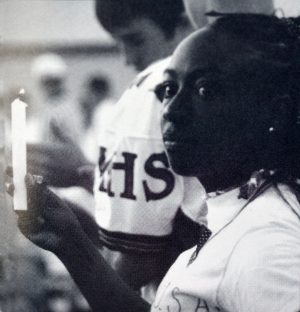In the midst of celebrating homecoming week, students, teachers pause to remember 9/11
Students in Mr. Winter’s third-period photojournalism class watch the 2011 documentary, Boatlift, which features first-hand accounts of the heroic effort of ordinary boat operators to rescue nearly half a million stranded New Yorkers in southern Manhattan in the wake of the 9/11 attacks on the World Trade Center.
September 11, 2019
Sept. 11, 2019, was something of an incongruous dichotomy. Students and teachers coursed through a Homecoming Week Wednesday, many of them wearing the goofiest of head-wear in order to celebrate the middle dress-up day of Homecoming Spirit Week.
And in the midst of that joyous celebration, the school also paused to remember and reflect on the tragedy that struck the nation 18 years ago to the day. In many ways, the refusal to stop enjoying normal activities has always been at the very heart of the American reaction to the terrorist acts of 9/11.
When the original 9/11 attacks happened in 2001, McCallum and Lake Travis high schools decided not to cancel the football game scheduled for Sept. 14. Instead the teams played the game, with fans on both sidelines wearing red, white and blue instead of school colors and holding a candlelight vigil at the game to honor the victims of the attacks. Cheerleaders sold the candles to raise money for Red Cross relief efforts.
So the decisions to live normally and commemorate 9/11 is really as old as the tragedy itself.
The task of leading today’s schoolwide observance fell to student council senior Sam Buford who read an AISD statement recounting the awful day of terrorism to the entire school at the start of first period.
“On the morning of Sept. 11, 2001, 19 terrorists attacked the United States,” Buford read.
The statement recounted the harrowing details of the day in short, clear sentences.
“They hijacked four passenger airliners in mid-flight,” the message continued. “The terrorists flew two of the planes into the North and South Towers of the World Trade Center in New York City. The impacts caused the buildings to catch fire and then collapse. Another plane destroyed a section of the U.S. military headquarters, the Pentagon, in Arlington, Va. The fourth plane, United Flight 93, crashed in a field near Shanksville, Pa. White House officials believe that the terrorists on that plane intended to destroy either the White House or the U.S. Capitol; evidence indicates that passengers on this flight resisted the terrorists’ efforts to carry out such a plan. In all, nearly 3,000 Americans were killed in the 9/11 attacks.”
Buford recounted the national and international response to the crisis and how it changed American culture in fundamental ways, leading to tighter security measures, laws and a subsequent war on terror. In Mr. Winter’s photojournalism classes today, students viewed one example of the heroic response of Americans in the face of the tragedy. At the suggestion of newspaper staffer Anna McClellan, Winter watched the 2011 documentary, Boatlift, that recounts the heroic efforts of boat operators to rescue a half-million New Yorkers stranded in southern Manhattan after all other transportation networks were shut down.
“It’s an amazing story,” Winter said. “I am so glad Anna mentioned it this morning. Both my afternoon photoj classes watched the movie very attentively. The story is just incredible not only because of what these ordinary Americans did but because of the message it sends that regular people can do great things when the situation requires them to.”
Narrator Tom Hanks said near the end of the film that the rescue operation is the greatest single sea evacuation in world history. By comparison, the evacuation of Allied soldiers at Dunkirk during World War II transported nearly 339,000 British and French soldiers safely across the English Channel in nine days. The 9/11 boatlift rescued 500,000 New Yorkers in less than nine hours.
The documentary provided one very powerful example of the message conveyed in the final paragraph of Buford’s morning announcement, which eulogized the victims who lost their lives that day and the many heroes who saved lives and restored order from chaos.
“Today we honor the memory of the lives that were lost on Sept. 11, 2001 in New York City, at the Pentagon, and in Shanksville, Pa. We remember the heroic efforts of our first responders and the individuals who sacrificed their own lives on United Flight 93 to prevent other Americans from losing theirs.”
Buford was able to volunteer to read today’s announcement because of his involvement in student council, but he told MacJournalism this evening that being able to speak to this issue today on the anniversary of the attacks meant much more than just an opportunity to volunteer.
“Being able to honor those fallen during 9/11 as well as during the war on terror really touched me,” Buford said. “It meant a lot to me because I plan for a career in the military.”
Buford hopes to start his military study and service at either West Point or the U.S. Naval Academy in the fall.








